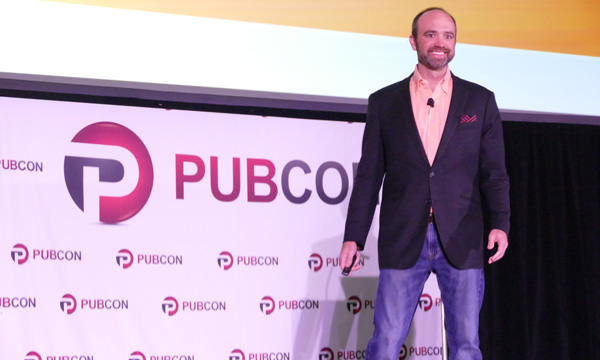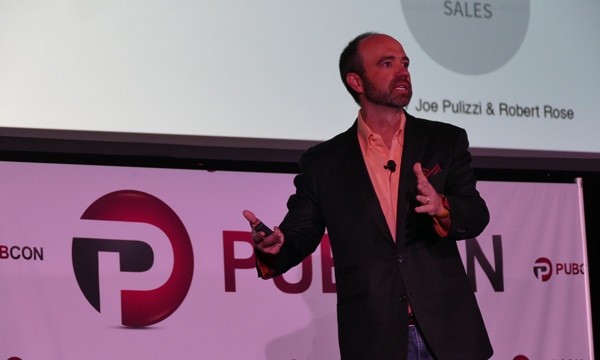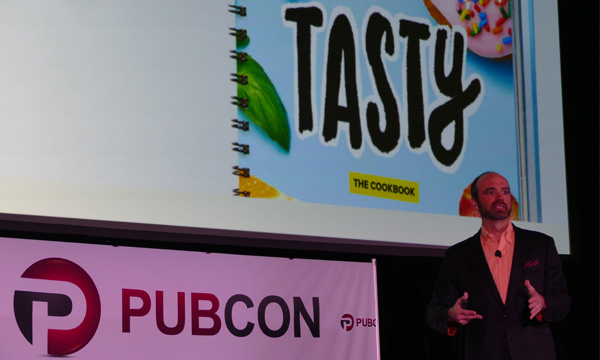
When it comes to any trade, the best practice is to learn from the best. So, who better to learn about content marketing from than Joe Pulizzi — the Founder of Content Marketing Institute — when it comes to turning your content into revenue?
Joe’s keynote presentation at Pubcon Pro in Las Vegas today focused on becoming a content brand and all that it entails.
Nine Content Brand Takeaways from the Godfather of Content Marketing:
1. Find a niche where you can be the leading expert in the world
This is what Joe calls ‘The Sweet Spot.’ It’s located at the intersection between knowledge or a skill area that you have and your key customer’s pain point. He used the example of John Deere, where they created content around agriculture and technology specifically for farmer’s trying to improve their operation.
2. Develop your content mission
Not to be confused with a general statement like ‘To create content that improves the lives of every possible customer in every possible way,’ the mission statement should be simple, yet specific to your audience. This is called the Content Tilt.
Joe used an example from Indium Corp, an industrial soldering equipment company. Their target audience was engineers, and they created a simple, yet effective mission statement: ‘Helping engineers answer the most challenging industrial solder questions.’
Their content then stemmed from that mission, resulting in their ‘from one engineer to another’ content series. For your mission statement, follow this formula:
- Determine your core target audience
- Identify what will be delivered
- Focus and define the outcome for the audience
3. Focus on one content type, platform and deliver consistently
One of the recurring and most important themes of Joe’s keynote was consistency. Consistency is what will make you successful. There are plenty of options for where and how to publish your content, but he created a simple formula for creating a base of content which the rest will naturally stem from:
The base =
- 1 content type
- + 1 main platform
- + consistent delivery
- + long period of time
You don’t have to do everything. Pick one type of content, on one main platform and NAIL it. Whether it’s on your blog, your podcast, in a newsletter — create a consistent cadence and experience.

4. Don’t build your house on rented land
When you build your audience on a platform you don’t control, you’re taking a risk. For example, when Facebook changed their algorithm, brands that had build up millions of followers found themselves in a sticky situation. The same can go for any platform you don’t own.
It’s ok to build your audience on other platforms, but your primary call to action for those followers should be a subscription to an owned property or list. For example, if you have a healthy, engaged YouTube following, start adding calls to action for them to subscribe to your email newsletter or your own blog. This mitigates the risk of frequently changing algorithms making a large impact on your bottom line.
5. Build an audience of opt-in subscribers
If you have a blog, add a subscribing functionality. Direct users on your website to subscribe to your email list. Of course, keep in mind that you need to offer content that aligns with their needs to move the needle on these subscriber metrics. And then, deliver that subscription content consistently.
6. Create an amazing e-newsletter and a remarkable download
An engaged subscriber base is incredible and has great value for your business, but your job is to give them a reason to open those newsletters you’re sending. The key to this is great content. Does your newsletter not only look great, but offer interesting, relevant and helpful content that your subscribers actually want to read?
This can come in the form of a downloadable piece of content — maybe that’s an eBook, some industry research, or a helpful template that helps your readers solve a business problem. This kind of asset should always stem from your mission statement.
7. Diversify after building your audience
Once you’ve built up a strong base audience, you can start to experiment with other content types. Have a successful Podcast? Why not try doing a weekly blog recap for each episode?
But it doesn’t have to stop there. Joe used Content Marketing Institute itself as an example. They started with a blog, then started an email newsletter, then diversified into a print magazine. All of that was followed by the creation of the Content Marketing World event that we all know and love.
8. Begin with one revenue option
While many content creators use display advertising as a way to monetize their digital properties, and it’s a successful and viable option, there are other ways to go about monetizing your content.

Joe used Tasty as an example. They had huge success with their recipe videos. They then turned that content into a printed cookbook which generated a substantial amount of revenue.
Starting with one revenue option is the essential step that turns your marketing department or team into a revenue center vs. a cost center. This kind of focus and the subsequent results can allow your team to stop asking for budget — because you’re generating measurable revenue.
9. Diversify revenue streams
Finally, once you’ve successfully monetized your content, you can diversify the ways in which you earn revenue.
Joe used Zappos as an example. They (literally) wrote the book on customer service, and it generated plenty of revenue. But they took it to the next level by offering training subscriptions to larger enterprise companies that actually taught managers and executives how to implement their employee and customer retention strategies.
That’s a whole lot of revenue coming in for a shoe company that has absolutely nothing to do with shoes.
As always, Joe shared great advice and examples anchored by his many years experience in the world of content marketing. Thinking beyond creating content for better search rankings or simply to generate leads was an eye opener. It is this kind of sophisticated approach to content that enables companies to turn their marketing department into a revenue-generating, world conquering team!
For more tips from Pubcon and the brilliant marketers who speak and attend, follow the TopRank Marketing team on the ground: @LaneREllis, @LeeOdden and @Tiffani_Allen. And, stay tuned for more insights over the next week on the TopRank Marketing blog.


